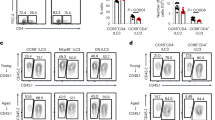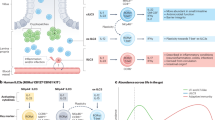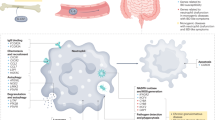Abstract
Immunosenescence is characterized by a quantitative decline of adequate immune responses, which renders the elderly individual particularly susceptible to bacterial, viral and fungal pathogens. Whereas changes of the aging adaptive immune system (for example, reduced immunoglobulin secretion) have been extensively characterized, alterations of the innate immune system are still poorly understood. The aim of the present study was to systematically examine mRNA expression levels of innate immune genes and proinflammatory cytokines in peripheral and intestinal leukocytes of subjects of different ages. In both, whole blood samples and in colonic biopsies most of the Toll-like receptors (TLRs) and nucleotide-binding and oligomerization domain-like receptors (NLRs) transcript levels were significantly downregulated in elderly subjects (90–99 years). Older individuals, when compared to the younger, exhibited an increased expression and/or secretion of proinflammatory cytokines by peripheral and intestinal leukocytes as well as an increased level of nuclear factor-κB activation in colonic biopsies. The observed downregulation of TLRs and NLRs during the aging process may contribute to the lack of effective recognition of invading pathogens or the commensal flora. This effect results in aberrant secondary immune cell activation and could significantly contribute to morbidity and mortality at advanced age.
This is a preview of subscription content, access via your institution
Access options
Subscribe to this journal
Receive 6 digital issues and online access to articles
$119.00 per year
only $19.83 per issue
Buy this article
- Purchase on Springer Link
- Instant access to full article PDF
Prices may be subject to local taxes which are calculated during checkout






Similar content being viewed by others
References
Walford RL . The Immunologic Theory of Aging. Copenhagen: Munksgaard, 1969.
De Greef GE, Van Tol MJ, Van Den Berg JW, Van Staalduinen GJ, Janssen CJ, Radl J et al. Serum immunoglobulin class and IgG subclass levels and the occurrence of homogeneous immunoglobulins during the course of ageing in humans. Mech Ageing Dev 1992; 66: 29–44.
Paganelli R, Quinti I, Fagiolo U, Cossarizza A, Ortolani C, Guerra E et al. Changes in circulating B cells and immunoglobulin classes and subclasses in a healthy aged population. Clin Exp Immunol 1992; 90: 351–354.
Pawelec G, Adibzadeh M, Solana R, Beckman I . The T cell in the ageing individual. Mech Ageing Dev 1997; 93: 35–45.
Medzhitov R . Toll-like receptors and innate immunity. Nat Rev Immunol 2001; 1: 135–145.
Philpott DJ, Girardin SE . The role of Toll-like receptors and Nod proteins in bacterial infection. Mol Immunol 2004; 41: 1099–1108.
Franceschi C, Bonafe M, Valensin S, Olivieri F, De Luca M, Ottaviani E et al. Inflamm-aging. An evolutionary perspective on immunosenescence. Ann NY Acad Sci 2000; 908: 244–254.
Franceschi C, Bonafe M . Centenarians as a model for healthy aging. Biochem Soc Trans 2003; 31: 457–461.
Caruso C, Candore G, Colonna-Romano G, Lio D, Franceschi C . Inflammation and life-span. Science 2005; 307: 208–209; author reply 208–9.
Krawczak M, Nikolaus S, von Eberstein H, Croucher PJ, El Mokhtari NE, Schreiber S . PopGen: population-based recruitment of patients and controls for the analysis of complex genotype-phenotype relationships. Community Genet 2006; 9: 55–61.
Schreiber S, MacDermott RP, Raedler A, Pinnau R, Bertovich MJ, Nash GS . Increased activation of isolated intestinal lamina propria mononuclear cells in inflammatory bowel disease. Gastroenterology 1991; 101: 1020–1030.
Reinecker HC, Steffen M, Witthoeft T, Pflueger I, Schreiber S, MacDermott RP et al. Enhanced secretion of tumour necrosis factor-alpha, IL-6, and IL-1 beta by isolated lamina propria mononuclear cells from patients with ulcerative colitis and Crohn's disease. Clin Exp Immunol 1993; 94: 174–181.
Rogler G, Hausmann M, Vogl D, Aschenbrenner E, Andus T, Falk W et al. Isolation and phenotypic characterization of colonic macrophages. Clin Exp Immunol 1998; 112: 205–215.
Losch A, Kainz C . Immunohistochemistry in the diagnosis of the gestational trophoblastic disease. Acta Obstet Gynecol Scand 1996; 75: 753–756.
Waetzig GH, Seegert D, Rosenstiel P, Nikolaus S, Schreiber S . p38 mitogen-activated protein kinase is activated and linked to TNF-alpha signaling in inflammatory bowel disease. J Immunol 2002; 168: 5342–5351.
Mann HB, Whitney DR . On a test of whether one of two random variables is stochastically larger than the other. Ann Math Statist 1947; 18: 50–60.
Hahnfeldt P, Sachs RK, Hlatky LR . Evolution of DNA damage in irradiated cells. J Math Biol 1992; 30: 493–511.
Akira S . TLR signaling. Curr Top Microbiol Immunol 2006; 311: 1–16.
Kanneganti TD, Lamkanfi M, Nunez G . Intracellular NOD-like receptors in host defense and disease. Immunity 2007; 27: 549–559.
Dinarello CA . The role of interleukin-1 in host responses to infectious diseases. Infect Agents Dis 1992; 1: 227–236.
Gehr G, Braun T, Lesslauer W . Cytokines, receptors, and inhibitors. Clin Investig 1992; 70: 64–69.
Renshaw M, Rockwell J, Engleman C, Gewirtz A, Katz J, Sambhara S . Cutting edge: impaired Toll-like receptor expression and function in aging. J Immunol 2002; 169: 4697–4701.
Flynn MG, McFarlin BK, Phillips MD, Stewart LK, Timmerman KL . Toll-like receptor 4 and CD14 mRNA expression are lower in resistive exercise-trained elderly women. J Appl Physiol 2003; 95: 1833–1842.
Boehmer ED, Goral J, Faunce DE, Kovacs EJ . Age-dependent decrease in Toll-like receptor 4-mediated proinflammatory cytokine production and mitogen-activated protein kinase expression. J Leukoc Biol 2004; 75: 342–349.
Bell MP, Svingen PA, Rahman MK, Xiong Y, Faubion Jr WA . FOXP3 regulates TLR10 expression in human T regulatory cells. J Immunol 2007; 179: 1893–1900.
Fiorentino L, Stehlik C, Oliveira V, Ariza ME, Godzik A, Reed JC . A novel PAAD-containing protein that modulates NF-kappa B induction by cytokines tumor necrosis factor-alpha and interleukin-1beta. J Biol Chem 2002; 277: 35333–35340.
Damiano JS, Oliveira V, Welsh K, Reed JC . Heterotypic interactions among NACHT domains: implications for regulation of innate immune responses. Biochem J 2004; 381 (Part 1): 213–219.
Yamamoto M, Sato S, Hemmi H, Sanjo H, Uematsu S, Kaisho T et al. Essential role for TIRAP in activation of the signalling cascade shared by TLR2 and TLR4. Nature 2002; 420: 324–329.
Bannerman DD, Erwert RD, Winn RK, Harlan JM . TIRAP mediates endotoxin-induced NF-kappaB activation and apoptosis in endothelial cells. Biochem Biophys Res Commun 2002; 295: 157–162.
Horng T, Barton GM, Flavell RA, Medzhitov R . The adaptor molecule TIRAP provides signalling specificity for Toll-like receptors. Nature 2002; 420: 329–333.
Boehmer ED, Meehan MJ, Cutro BT, Kovacs EJ . Aging negatively skews macrophage TLR2- and TLR4-mediated pro-inflammatory responses without affecting the IL-2-stimulated pathway. Mech Ageing Dev 2005; 126: 1305–1313.
Conti BJ, Davis BK, Zhang J, O'Connor Jr W, Williams KL, Ting JP . CATERPILLER 16.2 (CLR16.2) a novel NBD/LRR family member that negatively regulates T cell function. J Biol Chem 2005; 280: 18375–18385.
Carty M, Goodbody R, Schroder M, Stack J, Moynagh PN, Bowie AG . The human adaptor SARM negatively regulates adaptor protein TRIF-dependent Toll-like receptor signaling. Nat Immunol 2006; 7: 1074–1081.
Keller ET, Chang C, Ershler WB . Inhibition of NFkappaB activity through maintenance of IkappaBalpha levels contributes to dihydrotestosterone-mediated repression of the interleukin-6 promoter. J Biol Chem 1996; 271: 26267–26275.
Trebilcock GU, Ponnappan U . Induction and regulation of NFkappaB during aging: role of protein kinases. Clin Immunol Immunopathol 1996; 79: 87–91.
Ponnappan U . Regulation of transcription factor NF kappa B in immune senescence. Front Biosci 1998; 3: d152–d168.
Ivory K, Martin R, Hughes DA . Significant presence of terminally differentiated T cells and altered NF-kappaB and I-kappaBalpha interactions in healthy ageing. Exp Gerontol 2004; 39: 567–576.
Baldwin Jr AS . The NF-kappa B and I kappa B proteins: new discoveries and insights. Annu Rev Immunol 1996; 14: 649–683.
Kim HJ, Kim KW, Yu BP, Chung HY . The effect of age on cyclooxygenase-2 gene expression: NF-kappaB activation and IkappaBalpha degradation. Free Radic Biol Med 2000; 28: 683–692.
Franceschi C, Capri M, Monti D, Giunta S, Olivieri F, Sevini F et al. Inflammaging and anti-inflammaging: a systemic perspective on aging and longevity emerged from studies in humans. Mech Ageing Dev 2007; 128: 92–105.
Acknowledgements
We thank Dorina Oelsner, Tanja Kaacksteen and the study group PopGen for their technical assistance. This work was supported by grants from the Deutsche Forschungsgemeinschaft (SFB 617) and the National Genome Research Network (NGFN) from the German Ministry for Education and Research (BMBF) and the GeHA project from the FP6 program of the European Union. The funding sources had no influence on study design; collection, analysis and interpretation of data; writing of the paper and decision to submit it for publication.
Author information
Authors and Affiliations
Corresponding author
Additional information
Authors' contributions: PR, SD, AN and SS designed the study. SD, SN, BB, HE and SS were involved in the recruitment and collection of samples. SD and SN performed all laboratory work. SD, SN, PR and RH performed data analysis. Interpretation of data and writing of the manuscript were done by PR, SD and AN. SS proofread the manuscript prior to submission.
Conflict of interest
All authors have read and approved of the contents of the manuscript and none of the authors have competing financial interests. There is no significant overlap between the submitted paper and any other papers from the same authors under consideration or in press elsewhere.
Supplementary Information accompanies the paper on Genes and Immunity website (http://www.nature.com/gene)
Supplementary information
Rights and permissions
About this article
Cite this article
Rosenstiel, P., Derer, S., Till, A. et al. Systematic expression profiling of innate immune genes defines a complex pattern of immunosenescence in peripheral and intestinal leukocytes. Genes Immun 9, 103–114 (2008). https://doi.org/10.1038/sj.gene.6364454
Received:
Revised:
Accepted:
Published:
Issue Date:
DOI: https://doi.org/10.1038/sj.gene.6364454
Keywords
This article is cited by
-
The TNF-α antagonist etanercept reverses age-related decreases in colonic SERT expression and faecal output in mice
Scientific Reports (2017)
-
Mitochondrial dysfunction and oxidative stress activate inflammasomes: impact on the aging process and age-related diseases
Cellular and Molecular Life Sciences (2012)



